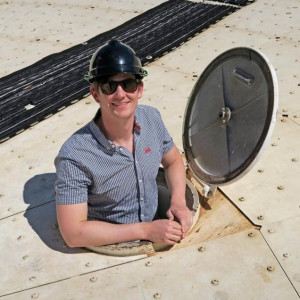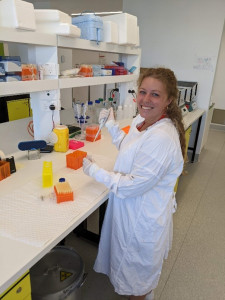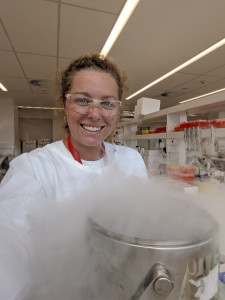The grandest of galaxies to the biology of the brain to the smallest of subatomic particles; scientists around the world are uncovering it all. Here, we meet some of Australia’s bright young minds and learn about their research.
“We observe electrons colliding with the energy of 11 lightning bolts.”
- Shanette De La Motte, PhD candidate
From Atoms to Galaxies
Shanette De La Motte is a physicist looking for new kinds of particle decay: the process by which a particle transforms into simpler, smaller and usually more stable constituents.
Most people have heard of ‘radioactivity’, which is the decay of unstable atoms. For example, carbon-dating of fossils is based on the decay of carbon-14, and smoke alarms operate based on the decay of americium-241. In Shanette’s work though, the starting material is much smaller than atoms – she deals with subatomic particles.
Shanette, a PhD candidate from the University of Adelaide, is investigating a particularly rare kind of decay of a subatomic particle known as a ‘B-meson’. B-mesons are exceedingly rare in nature and are very short-lived, but are more likely to occur in high-energy environments, such as immediately after the Big Bang, or in an electron-positron collider.
Like many subatomic particles, B-mesons are predicted to break down in a number of different ways – some of which are much rarer than others. Shanette is working on observing the B-meson particle decaying into two other subatomic particles: a muon and a neutrino. While it has been theorised, this decay has never been detected before – meaning Shanette would be the first person to observe and record it.
In her pursuit of this elusive physical phenomenon, she analyses data from the Belle II experiment – an ongoing experiment housed in a particle accelerator complex in Japan (pictured above), where particles are collided at extraordinary speeds. At this site, the B-meson decay is thought to occur only around 300 times per decade. Shanette believes her research will continue to advance scientific knowledge and an understanding of how particles behave on the smallest of scales throughout the universe.
“We’re emulating conditions in our particle accelerators that were present soon after the Big Bang… perhaps this research will help us understand where our universe came from.”
“The Voyager 1 is travelling at 60,000 km/h. A few years ago, it officially left the solar system… remarkably, Voyager 1 is still working and sending back useful data.”
- Dr. Danny Price, Senior Research Fellow
From Atoms to Galaxies
Although the Voyager 1 project was launched many decades ago, in 1977, it serves as a testament for the reach of humankind’s ability to observe the universe, and as inspiration for modern astronomers.
One such inspired astronomer is Dr. Danny Price, in Perth, Western Australia. Danny builds and upgrades advanced radio telescopes all over Australia, whose combined operation capture events far beyond the reaches of our planet, our solar system, and soon even our galaxy.
 |
 |
Danny is based in Curtin University as a senior research fellow, but is part of a number of international collaborations, including the Breakthrough Listen initiative: the most comprehensive search for extra-terrestrial intelligence ever undertaken in human history. This program is a multinational, multidisciplinary, decade-long survey of the closest million stars to Earth. It will even detect signals beyond our galaxy, listening to the ‘sounds’ of one hundred of the Milky Way’s closest galactic neighbours.
Danny is currently working on a new signal processing system for a telescope in Western Australia, which will scan the entire night sky every few milliseconds. These images are rapid and comprehensive enough to capture Fast Radio Bursts: incredibly short-lived but highly energetic events that appear to originate far across the universe, many billions of lights years away. They remain distant and difficult-to-study enigmas, but Danny’s research aims to bring us data that will clarify these extragalactic mysteries.
Although observing phenomena happening much further away and at much larger scales, Danny’s work is akin to Shanette’s - both scientists are harnessing incredible technologies to understand the mysterious and complex physical workings of our universe.
“I have a freezer full of brains at work.”
- Samara Brown, PhD Candidate
 |
 |
Beautiful Mind
Samara Brown is a neuroscientist completing her PhD in Wollongong, where she is investigating the molecular changes that underpin major depressive disorder. Specifically, she studies chemical processes that occur in the brain known collectively as the kynurenine pathway. Of the many chemicals produced in this pathway, Samara is particularly interested in two products which work in direct opposition to one another: one causes activation of certain receptors in the brain, whereas the other blocks it.
The levels of these two chemicals is critical for healthy brain function. Imbalances have been implicated in several illnesses such as schizophrenia, bipolar disorder, and Huntington’s disease. Research is now showing that imbalances between these specific products of the kynurenine pathway are also involved in depression.
Although major depressive disorder primarily involves the brain, most of the research in this space involves blood samples of those with clinical diagnoses of depression, leaving an important gap in our understanding of the disorder.
This is where Samara comes in.
Instead of conducting blood studies, she works with post-mortem brain tissue to identify changes in the kynurenine pathway. By comparing differences in the kynurenine system between a cohort of disease-affected brains and health controls, she will strengthen our understanding of the role of this crucial pathway. She hopes this research will lead to a better understanding of the physiology of depression and perhaps inform the development of new treatments.